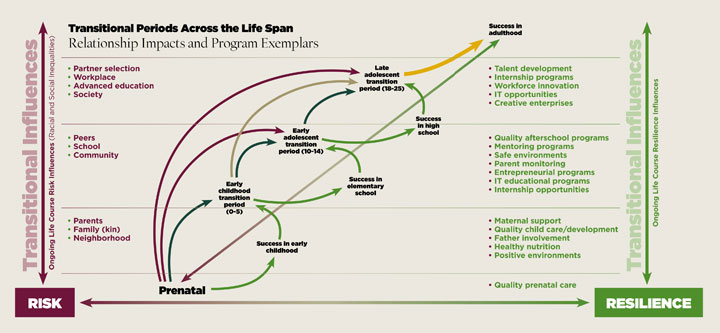Birth to Work: A Community-Driven Framework for Systems Change
- Hiram E. Fitzgerald
- Associate Provost for University Outreach and Engagement
- University Distinguished Professor, Department of Psychology, College of Social Science
For our 2010 issue, The Engaged Scholar Magazine asked three prominent scholars for their "Perspectives" on academic engagement with urban communities. This essay is Dr. Hiram E. Fitzgerald's response.
Using the "Power of We" to Transform Communities
Birth to Work (BTW) is a framework for systems network building and community transformation. It was developed by combining the resources of the Michigan Capital Area community, represented by the Power of We Consortium (PWC) and its various coalitions and agency partners—Ingham County Health Department, Capital Region Community Foundation, Lansing Community Economic Development Corporation, Lansing Economic Area Partnership, Lansing Community College, and Michigan State University—to promote positive transitions from birth to adulthood for all children in the metropolitan region, with special emphasis on those living in areas of concentrated poverty.
Nearly four years ago, the BTW framework was imagined and developed through a co-creative process that began with a hallway conversation where folks were trying to build a thematic connection among the Power of We, Community Foundation, and Michigan State University. We were searching for a way to organize PWC's extraordinarily diverse coalitions and partners around a common thematic in order to facilitate stronger connections to the diverse evaluation and research capacity of Michigan State University. Brainstorming somehow led to "birth to work" as a way of characterizing the breadth of PWC coalitions and agencies, and we have been co-creating this systems change concept ever since.

Targeting Systems Change
The BTW framework targets systems change by integrating and improving existing systems to form a seamless web of supports at key points in human development: birth to kindergarten, the middle school years, and emergent adulthood. Because it is a systems-based framework, it posits that systems change must take place at multiple levels—individual, family, neighborhood, and community—in order for children to successfully negotiate the first 25 years of the life cycle.
Mapping the Risk-Resilence Continuum
The BTW framework is based on what appears to be a simple concept, that, in fact, is extraordinarily complicated. The concept is the risk-resilience continuum. This continuum posits that over the life course every child's life space can either be described as risk-oriented or resilience-oriented, and that this description will change within and across segments of the life cycle. So, children can be at risk because of individual characteristics, family characteristics, or social environment characteristics. When at risk, events can maintain or exacerbate risk, or risk can be reduced through appropriate family, community or social system interventions.
"Birth to Work is about building and maximizing the resilient pathways that enable each individual to become a productive and engaging member of a civic democratic society."
Hiram E. Fitzgerald
As indicated in the graphic above, the BTW framework is both vertical (life course) and horizontal (dealing with present issues), utilizing both feed-back (what happened in the past should be linked to current performance) and feed-forward principles (what is happening now should influence future performance), in ways that encourage preventive interventions, schools, parents, and others to view the life course as interconnected and continuous. Thus, programs targeting youth can pool their resources, integrate across missions, and bring more cohesion, resource sharing, and economy to current interventions, while simultaneously focusing on longer-term impacts. Cross-cutting risk factors such as racial and social inequities are addressed openly so that public policies and public behaviors can be shifted from the risk to the resilience side of the continuum.
Enhancing Resilience, Reducing Risk
The BTW framework is designed to enhance children's resilience experiences and reduce their risk experiences, especially during the three core transitional ages previously noted. As it has evolved, the BTW framework goal is to help build successful individuals, families, and communities and maximize the resilient pathways that enable each individual to become a productive and engaging member of a civic democratic society. To reach this lofty but essential goal requires the integrated input of family, community, education, faith based institutions, law enforcement, business, and all other facets of civic society.
What began as a Lansing regional approach to systems change is now evolving with partnerships in Flint, Detroit, Dearborn, Battle Creek, and Kalamazoo. Because it is community based, the BTW framework will vary from one community to another, but its underlying structure will hold true: Provide the necessary optimal environments that will build opportunities for every child in Michigan to move successfully from birth to adulthood with the skills necessary to be a productive, successful, and civically minded participant in the knowledge economy of the 21st century.